- Home
- John Updike
Higher Gossip: Essays and Criticism Page 4
Higher Gossip: Essays and Criticism Read online
Page 4
I would have begun to suspect a put-on, an impish tricksterism leading to some intricate fraud, except that irony doesn’t carry across the Mississippi; Ivy League graduates have to fly it over the nation’s great heartland direct to Hollywood. Itching to turn my back on this encounter, I reminded myself that here in the desert people have a stake in one another, especially people over a certain age. We have come out here to put our striving to rest, amid barren landscapes and big-box stores. “I’d be happy to,” I told the other old man, “but I have no paper, and no pen. Do you?”
Together we looked around for a piece of paper lying on the asphalt or among the cacti, and saw none. “What do you need?” the younger man called over to us. “Paper?”
“And a pen,” the merry old gentleman said. Both items were produced, and, when I scanned the environment for a desk or lectern to sign at, a clipboard appeared. Sighing with the unexpected exertion, I signed my name. Still, my fresh acquaintance wanted more. “And the name and address of the organization,” he said. “Did you hear,” he asked our provider, who was patiently waiting for the return of his pen and clipboard, “what a wonderful organization he belongs to? It does all this good.”
“You know,” I confided to him, willing to be frank now that I foresaw our encounter soon ending, “this is beginning to be humiliating.”
“I know.” He smiled. “But isn’t it nice? Writers, composers, sculptors.” They were for him, it seemed, a faraway frieze, on the eastern rim of possibility. They loomed, as our membership had been intended to loom, as immortal. “And its phone number.”
This was too much. “I don’t know it,” I told him, truthfully.
I had signed the back of a Roto-Rooter invoice. My petitioner tucked it, twice folded, into the pocket of his striped shirt, and handed back to the third man his ballpoint pen. “Hasn’t this been something?” he asked the repairman, who didn’t deny it. I could hear my wife calling my name, beyond the shorn hedge and the pruned ocotillo. Trash collectors will not touch ocotillo—it is too invincibly thorny—and my trimmings lay in an uninviting heap on the dusty, stony caliche. Slipping backward out of the old man’s magnetic field, I looked for the first time at his shoes; they were not the bloated patchwork running shoes with which the elderly in the Southwest anchor and ease their weary feet but real shoes, two-tone wingtips, like those of a dancer in a musical comedy. Along with the point of his cane, they held him there, on the slant surface, defying gravity. Dressed with a brave brightness, he had been headed for some festivity, and had confused the festivity with me. The encounter, when all was said and done, had been no stranger than those in Krazy Kat, which had given me my first idea of the American desert.
The dusk was threatening to enwrap us. The calls of the golfers to one another had been silenced. At our feet a sizable city had begun to display its shimmering grid. The Roto-Rooter operative moved, uncertainly, toward the driver’s door of his truck. I felt that some concluding statement was expected from me. “I am delighted,” I announced, “to have my hat back,” and tipped it, floppy as it was, to the two of them, first one and then the other, overcoming my fear that they might suspect irony, where none was intended.
NESSUS AT NOON
—slip enclosed with a dry-cleaned item
SCENE: A dry-cleaning establishment, between a pizza parlor and a nail salon, in a small American strip mall. Cleaned clothing hangs in transparent bags from movable racks on tracks, right up to the ceiling, thick as bats in a cave before sunset. The counter, on the other hand, is exiguous.
CUSTOMER (entering, brandishing garment): I’ve inspected this garment carefully and can find nothing the matter with it.
CLEANER: Really? Oh, dear. You honestly don’t see it?
CUSTOMER (rotating garment once more under his eyes): No, frankly. To me it seems perfectly fine.
CLEANER: Well, our customer notes say we did the best that could be done.
CUSTOMER: But what was wrong with it in the first place? A spot of gravy? Salad dressing? Sweat stains under the arms or around the pockets? Be honest. Don’t worry about my hurt feelings.
CLEANER (gingerly inspecting, at a polite distance): You know, sir, we really can’t be expected to remember every garment that passes through our system. We meticulously clean hundreds of garments every day.
CUSTOMER: Yes, but you’re implying here in this note that you somehow failed. Something successfully resisted your best effort. You did the best that could be done, and it still wasn’t enough.
CLEANER (up on his toes, almost smiling): Where do we say that it wasn’t enough?
CUSTOMER: You say “Sorry.” How can I go anywhere wearing something that made my dry cleaner say “Sorry”? See, here it is, right after the checked box. “Sorry.”
CLEANER: We don’t say you shouldn’t wear it. That’s your choice. Among your family and close friends, it probably won’t matter. They’re used to you. Poor old Pops, his clothes a disgrace, his shirttails always hanging out. There’s something in it for them, I’m sure, in forgiving you your little eccentricities. (Sneeringly.) Your foibles, your lovable weaknesses. (Chuckles to self.) Who was it who on his deathbed, asked by some officious person if he thought God would forgive him, responded, “Yes. Forgiveness is His métier”?
CUSTOMER: I have no idea. You wonder about these clever deathbed remarks, if they ever really got said, don’t you?
CLEANER: Yes, one does wonder. It was allegedly Heinrich Heine, the German poet.
CUSTOMER (persisting): But, in this instance, what’s to forgive? Tell me what didn’t pass muster with this garment.
CLEANER: Sir, please. I can’t say it’s against our policy to tell, because such a request is so rare that we have no policy. If you see nothing wrong with the garment, then there is nothing wrong. Wear it with pride and confidence. Frankly, it’s not the worst piece of goods we’ve ever had to handle. See no evil, hear no evil, smell no evil—isn’t that the rubric?
CUSTOMER: Speak no evil. (Holds garment up to face, and inhales.) I don’t smell anything funny about it.
CLEANER (as if in happy conclusion): There you are! Forget our fussy old customer notes! Sally forth, as the bridegroom said whose previous three wives had also been named Sarah. (Attempts to turn to the next customer.)
CUSTOMER (obdurately standing and continuing to inspect garment): Here’s a thread that might start to unravel some day. Is that what you meant? Or, at the seam, you can see where the two fabrics might not have been from exactly the same dye lot…
CLEANER (gazing, with a pointed serenity, over CUSTOMER’s shoulder): We did the best that could be done.
CUSTOMER (desperately confiding): This is destroying me, you know. How can I sally forth, as you say, dressed in your relative failure? It will eat me alive. Like the mythical shirt of whoever it was.
CLEANER: Nessus. He gave it to Hercules to wear. It took off pieces of the hero’s skin and led him to build his own funeral pyre and immolate himself.
CUSTOMER: Is that what you hope to drive me to?
CLEANER (at last relenting): Oh, very well. Hold the garment up to yourself. Under your chin. That’s it. Try to smile, and look in the mirror. Now do you see it?
CUSTOMER: See what? No.
CLEANER: That garment. Dear boy, it’s simply not you.
THE FOOTBALL FACTORY
THE DIGNITARY was surprised that the factory was located in farm country—a gently rolling plain hazy with pollen and tractor exhaust, not so different from the guileless land where, a half-century ago, he had been born. Corn had been the crop there, while here interminable dull-green rows of potatoes dominated, with some fields given over to the slightly broader and brighter stripes of pick-them-yourself strawberries, tidily mounded between weed-suppressing strips of black plastic. The factory itself was low, its flat roof only one visual notch higher than its parking lot, and but for the violent, multi-colored glitter of the rows of parked cars would hardly have interrupted the landscape.
&nb
sp; The company president and the floor manager, both wearing shirts and ties but coatless, greeted the dignitary’s party at the entrance, a small door to one side of a long concrete loading platform. The chief of the delegation, the local mayor, introduced first the dignitary, then the reporter and the press photographer who would accompany their brief tour. The mayor, knowing the dignitary’s tight schedule, emphasized the “brief.” The company president, who wore conspicuous cufflinks in the form of gold footballs, was pink with pleasure, whereas the floor manager, who was to conduct the tour, appeared relatively sallow and tense; he gave them all their protective goggles and red plastic safety hats without any of the playfulness, the sheepish sense of childish fun, that such a procedure usually elicits. To be polite and to lubricate the encounter, the dignitary asked the president if there had been any significant recent changes in their manufacture of footballs.
The question seemed to be an awkward one. The president’s china-blue eyes slid around his office, from desktop to filing cabinet to industrial-performance plaques to an oversized display football to a framed letter from a former regional sports hero to the face of his floor manager, finding the answer nowhere. “Well,” he said, “there’s always subtle changes—an eighth of an inch here, a degree or two of curvature there—but the last revolutionary step was the half-circle on the end, instead of the full circle. That was really the last major innovation. Before that, all I can think of is the clear plastic bladder, for the less quality models.”
The dignitary became interested in spite of himself. “Who determines these changes? The league heads?”
“Supply and demand, like everything else,” the president said, his pinkness intensifying but his appearance of pleasure ebbing. “Changes trickle down from the leagues, yes, but there’s also a trickle-up effect, from the schools and colleges. You get younger pro players used to a certain style of pebbling on the leather, a certain specific amount the laces are spaced and raised up, they’re going to be most comfortable with it all the way along, way into their careers. We don’t make policy here, we just make footballs.”
The president’s palpable relief at having arrived at a joke of sorts, after so long a traversal of what seemed to be thin ice, communicated itself to the group and released them to their tour. The floor manager led the visitors down a long wooden hall, past a bulletin board and time clock and production charts and a pair of lavatory doors marked Heifers and Steers, and opened a steel portal into bedlam—a controlled, steady bedlam of clanging, huffing, rattling, stitching, stamping, and breathing. A giant presiding set of lungs seemed to be inhaling and exhaling through the mechanical din, as if about to pronounce an anguished word. To the almost blinding richness of activity and noise was added the intermittent flash of the photographer’s camera as he recorded the dignitary intently observing different aspects of football manufacture.
The delegation was led around to the far side of the huge room, through lanes of machines and workers who seemed no more conscious of the visitors than the machines were, to a corrugated wall half hidden by mountains of hides. “We try to keep the inventory low,” the floor manager explained, slapping a broad stack that came up to his chest. “Inventory ties up cash.” In the din, his shouted words were precious, and had to be strained after. Often, he merely gestured.
First, the hides (imported from Argentina, Florida, and Texas) went to a young woman at a machine that stamped big pumpkin-seed shapes from them. It was wonderful, to see how quickly she placed the oval die, snatched back her hand, let the machine descend and lift with a hollow plucking sound, laid the punched piece of leather in a stack, and shifted the hide and die for another such quick subtraction. When all the pieces were stamped out, the waste remnant, minimal and tangled like a wet bikini, was tossed into a barrel. It somehow surprised the dignitary that the hides, whitish on their unpebbled side, still testified to the four-legged shape of the steer, and bore organic irregularities that were taken into account by the deft worker: she did not relegate all the leather pieces to the same stack but graded them into three or four stacks as she worked. She had the pensive pale profile of a maiden rendered in Art Nouveau stained glass, and ringleted blond hair caught up into a tight red polka-dot kerchief, and long arms whose motions unfailingly glided in silent obedience to the rhythm of the machine; she formed, in her young and pensive beauty, a human island in the midst of clatter. Even through the veils of mechanical fervor, the intensity in the dignitary’s contemplation of her profile must have made itself felt, for she glanced aside, risking in that moment’s inattention severance of her fingers.
The floor manager, his initial tension expansively relaxing as he settled into his field of expertise, was explaining the nuances of hide—the relative thicknesses and consistencies of the shoulders versus the flanks, and the problem of barbed-wire scratches and gorings acquired by the animal in its wandering, irresponsible, pre-football condition.
The group moved on, to terrible machines where whiningly revolving bands of steel shaved the ovoid leather pieces to a uniform thickness. The workers here were sitting down, and with a certain insouciance flipped the pieces in and out and onward. Travelling belts transported square gray buckets of leather from one process to the next. Four pieces made a football, and soon the pieces met their fated companions and travelled in quartets, in two-pointed four-ply sandwiches, of which two pieces were punctured with lace-holes and one with another hole to admit the bladder valve. At a kind of printing press fed with gold and black foil, one of the four pieces was branded with the company’s name and logo. At rows of industrial sewing machines, pairs of sides were sewn together; huddled women peered into spots of light where their tenacious fingers guided the doubled leather along a single curved edge stitched by a chattering needle. Then the two halves, nested together, shaped like open pods, were sewn into a single unit, at machines even more powerful, by women and men even more highly trained, than at any previous stage. The floor manager shouted, “Takes four to six years’ experience to be trusted with this procedure. Toughest part is the tips. See how they trim a little bit off? Otherwise there’d be too much to drive the needle through. You’d get a sort of lump at the end.”
The dignitary stared at the brightly illuminated hands that with habituated sureness and strength perfectly pulled the doubled leather along its curve, around the acute corner, back up the other side, around the other corner, back to the patch for laces, cut the thread, and finally tossed the wadded, limp, hopeless-looking result into a waiting square gray bucket. The photographer’s blue flash kept bursting in his face; he hoped his expression was suitably fascinated. He asked, “Don’t they ever get bored? I mean, do you ever get employee burnout?”
A hint of tension returned to the manager’s sallow visage. “Not at the prices we pay ’em,” he said. “This is one of the top jobs. Like I say, four to six years’ experience before they can handle it.” Quite unexpectedly, he smiled. “Now I bet you’re asking yourself the question everybody takes this tour asks themselves.”
“What’s that?”
“How do the footballs get turned right side out?”
Belatedly the dignitary realized that the hopeless-looking assemblages of leather were inside-out footballs. Amid the many impressive, implacable machines he had lost sight of basic objectives. He wondered if he were especially stupid or merely innocent regarding the rigorous, intricate, and yet basically blunt steps whereby things are made. His whole adult life had been spent in the realm of the immaterial—speaking, thinking, performing, conferring, making impressions on men’s minds. His childhood acquaintance with matter and its earthly principles had been perfunctory and not pleasant enough to prolong. He had yearned for a life free of dirt and calluses, and his success was measured by how much time he now spent on airplanes. Only in airplanes, above the clouds, going somewhere at someone else’s expense, did he feel fully himself—impervious, clean, transient, a lord of thin air.
“People always love the turners,�
� the floor manager assured him, smiling as if an obscene treat were in store.
Before they could witness the turners at work, the delegation had to admire the computerized assembly lines, whereby a laborer at any machine could, with a touch, signal for more units to stitch or punch, and a gray container would be sent on its programmed way. The lanky lad manning the multi-colored computerized control panel slapped down a bucket of grayish ovoid liners, of what looked like felt or cardboard; the dignitary had somehow missed the part of the process where the leather was lined. And then another slapped-down bucket, of half-moon-shaped reinforcement patches for underneath the lace-holes, skimmed on its zigzag way. There was more to making a football than met the eye. The flashbulbs went off with less regularity now, and the dignitary felt his brain wearying. The mayor, too, who had been on this tour many times, and the press reporter, his ballpoint pen tucked back into his corduroy jacket, looked drowsy and overwhelmed, here at the acoustical center of the circumambient din.
But the turners woke them up. A row of men, standing each at a bench equipped with a knobbed upright metal post, writhed like damned souls as, muscles bulging through their T-shirts, they whacked the limp inverted footballs over their posts, pushing one point in, and then with savage yet skilled tugging brought the point out through the gap left for the lace-holes and, twisting the impaled, half-actualized football tenaciously about, with more whacking and tugging, brought the other end through, and tossed the result, its thick seams now turned inward, into a gray bucket. The ordeal took less than a minute. The footballs then moved along to a group entirely of women—because, the floor manager shoutingly explained, their hands were small—who inserted the bladders and gave each a whiff of air. The machines that provided air, tall shining canisters such as contain milk in cafeterias, were what had initially struck the dignitary’s ears as the sound of lungs, of breathing, of intake on the verge of speech, permeating the mechanical agitation. From the bladder-inserters the footballs passed on to the lacers; these, too, were all men, because of the brute strength required, but their dance of frantic effort was performed sitting down, with a length of thong and a slender hook that became in their gauntleted, bandaged hands a shuttle that with furious speed wove shut the football.

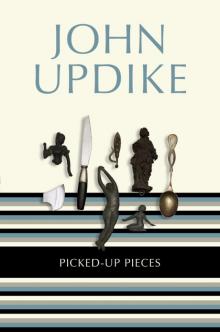 Picked-Up Pieces: Essays
Picked-Up Pieces: Essays Bech: A Book
Bech: A Book Roger's Version: A Novel
Roger's Version: A Novel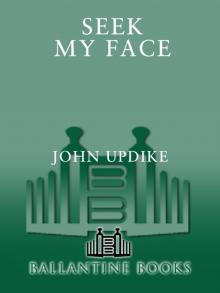 Seek My Face
Seek My Face The Carpentered Hen
The Carpentered Hen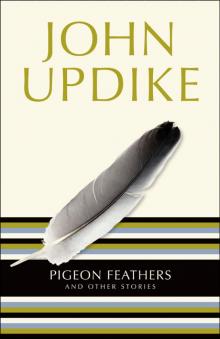 Pigeon Feathers: And Other Stories
Pigeon Feathers: And Other Stories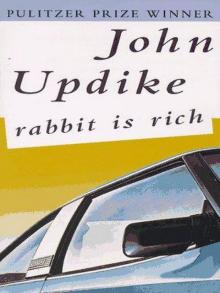 Rabbit Is Rich
Rabbit Is Rich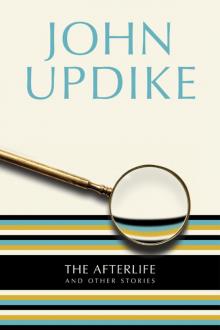 The Afterlife: And Other Stories
The Afterlife: And Other Stories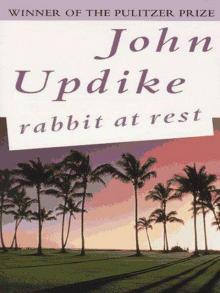 Rabbit at Rest
Rabbit at Rest The Witches of Eastwick
The Witches of Eastwick Gertrude and Claudius
Gertrude and Claudius Bech Is Back
Bech Is Back Hub Fans Bid Kid Adieu: John Updike on Ted Williams
Hub Fans Bid Kid Adieu: John Updike on Ted Williams Marry Me: A Romance
Marry Me: A Romance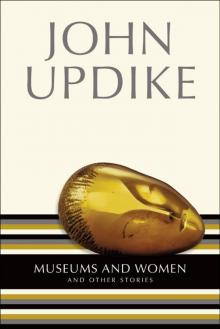 Museums and Women: And Other Stories
Museums and Women: And Other Stories My Father's Tears and Other Stories
My Father's Tears and Other Stories Collected Poems, 1953-1993
Collected Poems, 1953-1993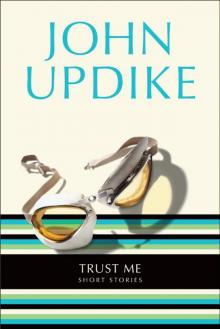 Trust Me: Short Stories
Trust Me: Short Stories Odd Jobs: Essays and Criticism
Odd Jobs: Essays and Criticism Rich in Russia
Rich in Russia Higher Gossip: Essays and Criticism
Higher Gossip: Essays and Criticism The Widows of Eastwick
The Widows of Eastwick In the Beauty of the Lilies
In the Beauty of the Lilies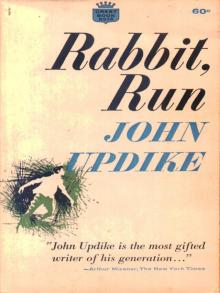 Rabbit, Run
Rabbit, Run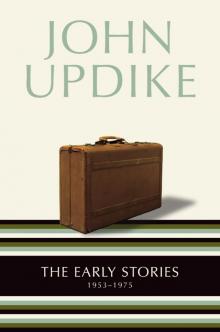 The Early Stories: 1953-1975
The Early Stories: 1953-1975 Rabbit Redux
Rabbit Redux S.
S. Brazil
Brazil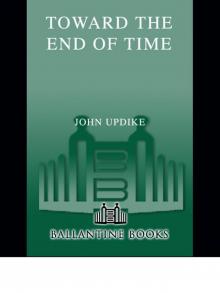 Toward the End of Time
Toward the End of Time The Centaur: A Novel
The Centaur: A Novel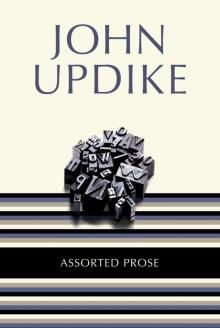 Assorted Prose
Assorted Prose Memories of the Ford Administration
Memories of the Ford Administration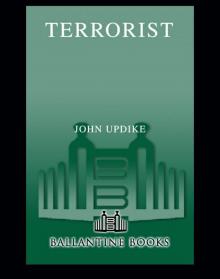 Terrorist
Terrorist Couples: A Novel
Couples: A Novel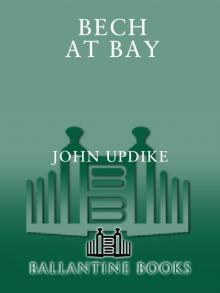 Bech at Bay
Bech at Bay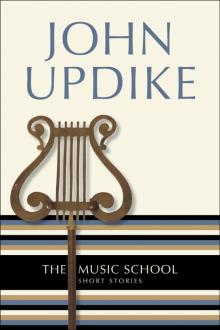 The Music School: Short Stories
The Music School: Short Stories Villages
Villages S
S Roger's Version
Roger's Version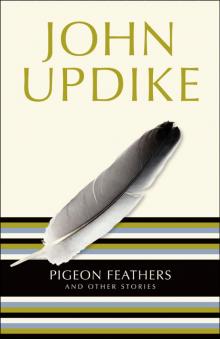 Pigeon Feathers
Pigeon Feathers Higher Gossip
Higher Gossip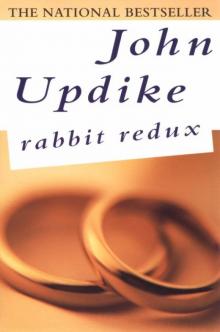 Rabbit Redux r-2
Rabbit Redux r-2 Memories of the Ford Administration: A Novel
Memories of the Ford Administration: A Novel The Centaur
The Centaur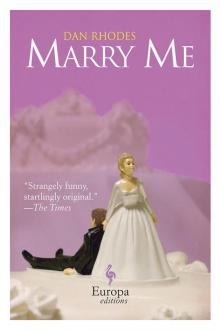 Marry Me
Marry Me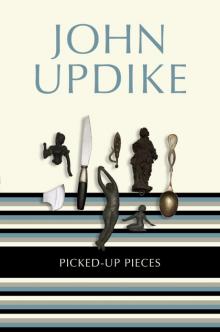 Picked-Up Pieces
Picked-Up Pieces Bech
Bech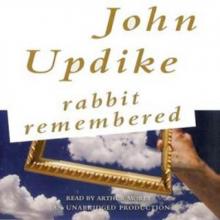 Rabbit Remembered
Rabbit Remembered Trust Me
Trust Me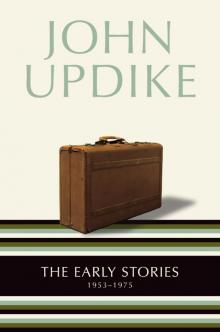 The Early Stories
The Early Stories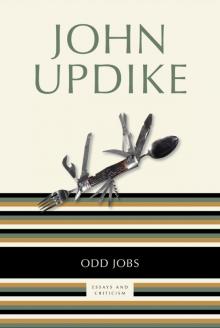 Odd Jobs
Odd Jobs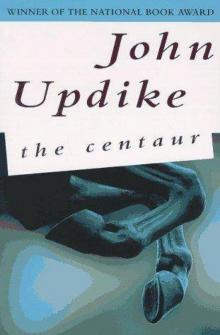 The Centaurus
The Centaurus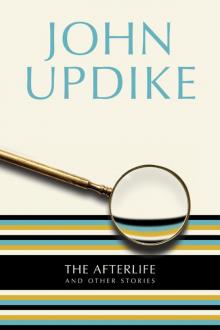 The Afterlife
The Afterlife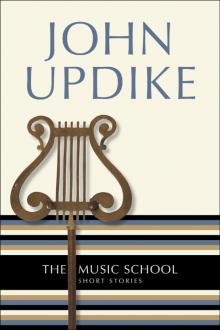 The Music School
The Music School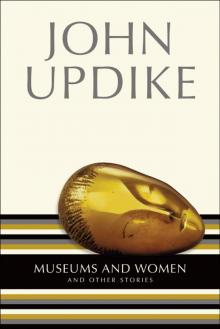 Museums and Women
Museums and Women Couples
Couples